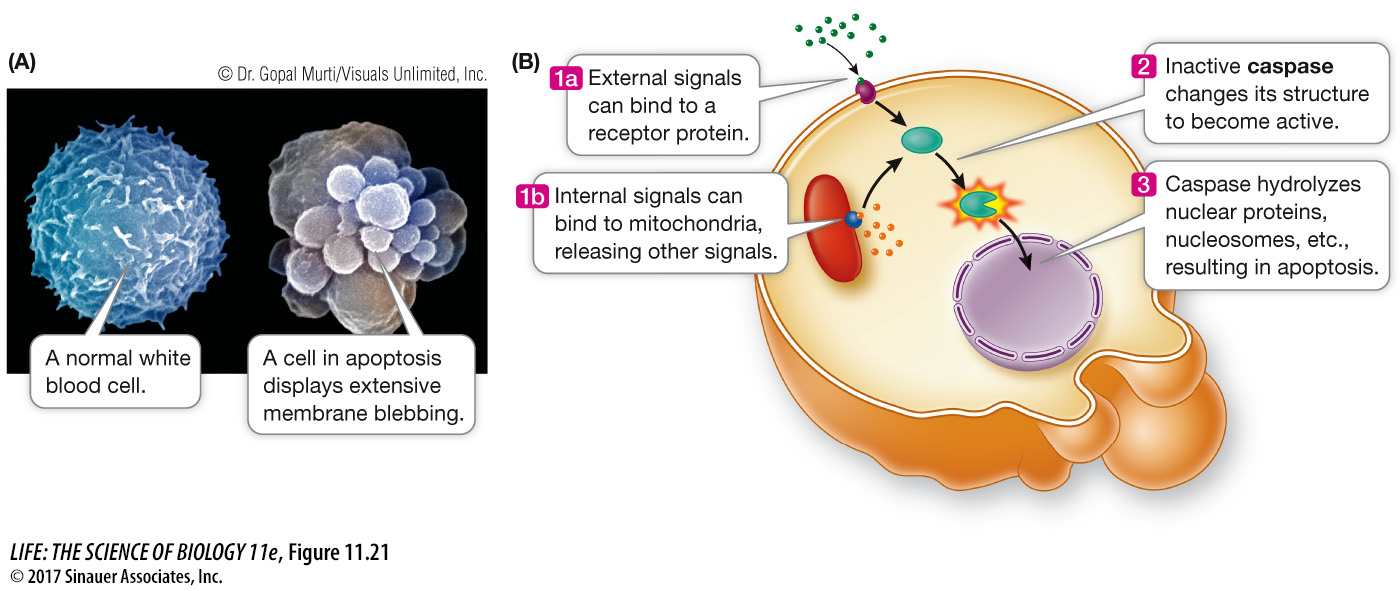Programmed cell death removes cells that do not benefit the organism
In animals, there are two possible reasons for apoptosis:
The cell is no longer needed by the organism. For example, before birth, a human fetus has weblike hands, with connective tissue between the fingers. As development proceeds, this unneeded tissue disappears as the cells undergo apoptosis in response to specific signals.
The longer cells live, the more prone they are to genetic damage that could lead to cancer. This is especially true of epithelial cells on the surface of an organism, which may be exposed to radiation or toxic substances. Such cells normally die after only days or weeks and are replaced by new cells.
The events of apoptosis are similar in many organisms. The cell becomes detached from its neighbors and its chromatin is digested by enzymes that cut the DNA (between the nucleosomes) into fragments of about 180 base pairs. The cell forms membranous lobes, or “blebs,” that break up into cell fragments (Figure 11.21A). In a remarkable example of the economy of nature, the surrounding, living cells usually ingest the remains of the dead cell by phagocytosis. Neighboring cells digest the apoptotic cell contents in their lysosomes, and the digested components are recycled.

Question
Q: Apoptosis is present in most organisms, with a common molecular pathway. This indicates that apoptosis is important in terms of evolution. What might be a selective advantage for apoptosis?
Apoptosis may be a way to eliminate cells that might develop mutations causing the cell to be harmful to the organism, such as a normal cell turning into a cancer cell. In addition, as an organism develops, organs must be a defined size and shape. Apoptosis may eliminate excess cells that would make an organ too big or misshapen.
234
Apoptosis is also used by plant cells, in an important defense mechanism called the hypersensitive response. Plants can protect themselves from disease by undergoing apoptosis at the site of infection by a fungus or bacterium. With no living tissue to grow in, the invading organism is not able to spread to other parts of the plant. Because of their rigid cell walls, plant cells do not form blebs the way animal cells do. Instead, they digest their own cell contents in the vacuole and then release the digested components into the vascular system. You will learn more about this in Chapter 38.
A variety of signals, either external or from inside the cell, can lead to programmed cell death (Figure 11.21B). Such signals include hormones, growth factors, viral infection, certain toxins, or extensive DNA damage. These signals activate specific receptors, which in turn activate signal transduction pathways leading to apoptosis. Some apoptotic pathways target the mitochondria, for example, by increasing the permeability of mitochondrial membranes. The cell quickly dies if its mitochondria can’t carry out cellular respiration. An important class of enzymes called caspases are activated during apoptosis. These enzymes are proteases that hydrolyze target molecules in a cascade of events. The cell dies as the caspases hydrolyze proteins of the nuclear envelope, nucleosomes, cytoskeleton, and cell membrane.